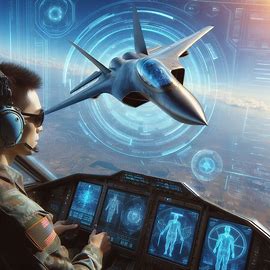
Introduction: The Rise of Artificial Intelligence in Military Aviation
Artificial Intelligence (AI) is revolutionizing multiple sectors, and military aviation is no exception. As AI technologies become more sophisticated, questions arise about the future role of human pilots in the cockpit. Will AI eventually replace pilots, or will it act as an advanced tool augmenting human decision-making? This article explores the current and future impact of AI in military aircraft, examining its capabilities, limitations, and implications for pilot roles and air combat strategy.
We will dissect the evolution of AI integration, its applications in unmanned and manned systems, and analyze whether pilots are truly on the path to obsolescence or if a hybrid human-AI partnership is the likely outcome.
1. Understanding AI’s Role in Military Aviation
1.1 What Is AI in Military Aircraft?
AI in military aircraft refers to computer systems designed to perform tasks that typically require human intelligence, such as learning, problem-solving, and decision-making. These systems include:
-
Autonomous navigation and flight control
-
Threat detection and response
-
Mission planning and real-time strategy adaptation
AI technologies encompass machine learning, neural networks, and natural language processing to enhance operational effectiveness.
1.2 The Spectrum: From Automation to Autonomy
AI integration ranges from basic automation—such as autopilot systems—to fully autonomous unmanned combat aerial vehicles (UCAVs) capable of executing complex missions without human intervention.
-
Assisted systems: AI supports pilots by managing routine tasks or providing real-time data analysis.
-
Semi-autonomous operations: AI controls specific mission aspects while pilots retain ultimate authority.
-
Fully autonomous drones: Capable of independent target acquisition and engagement.
Understanding this spectrum clarifies that AI’s role is not binary but multifaceted and situational.
2. Current Applications of AI in Military Aircraft
2.1 Enhancing Pilot Situational Awareness
One of AI’s primary benefits lies in processing vast amounts of sensor data to aid pilots:
-
Sensor fusion: Combining radar, infrared, and electronic intelligence into a unified picture.
-
Threat prioritization: AI algorithms assess and rank threats for pilot attention.
-
Predictive analytics: Anticipating enemy movements or system failures.
These systems reduce pilot workload and improve decision accuracy under high-stress conditions.
2.2 Autonomous Flight and Drone Operations
Unmanned aerial vehicles (UAVs) are a direct result of AI advancements:
-
Surveillance drones conduct persistent reconnaissance missions.
-
Combat drones perform strike missions with remote human oversight or full autonomy in testing phases.
-
Swarm technology: Multiple AI-driven drones coordinate attacks, reconnaissance, or defense.
Examples include the MQ-9 Reaper drone and experimental programs exploring autonomous dogfighting.
2.3 AI in Maintenance and Logistics
Beyond flight operations, AI optimizes aircraft maintenance and mission logistics:
-
Predictive maintenance: AI analyzes sensor data to predict component failures.
-
Resource allocation: Optimizing fuel, armament, and mission scheduling.
-
Training simulators: Adaptive AI-driven simulators tailor pilot training to individual needs.
Such applications increase aircraft readiness and reduce operational costs.
3. Are Pilots Becoming Obsolete? Analyzing the Debate
3.1 Arguments for AI Replacing Pilots
Advocates for AI-driven combat systems highlight several points:
-
Reduced human risk: Eliminating pilots from high-risk missions saves lives.
-
Faster reaction times: AI can process data and execute maneuvers faster than humans.
-
Endurance and persistence: Autonomous drones can operate continuously without fatigue.
These advantages suggest a future where human pilots may no longer be necessary in frontline roles.
3.2 Arguments for Human Pilots’ Continued Relevance
Despite AI’s growth, there are compelling reasons for retaining human pilots:
-
Ethical and legal accountability: Humans are necessary for lethal decision-making responsibility.
-
Complex judgment and adaptability: Pilots can intuitively interpret ambiguous situations.
-
Cybersecurity concerns: AI systems can be vulnerable to hacking or malfunctions.
Many experts advocate for a hybrid approach combining AI efficiency with human oversight.
4. The Future of Human-AI Collaboration in Military Aviation
4.1 Manned-Unmanned Teaming (MUM-T)
MUM-T refers to operations where human pilots coordinate with AI-driven drones or autonomous vehicles.
-
Force multiplication: One pilot can control multiple unmanned assets.
-
Enhanced battlefield awareness: AI drones provide data and tactical support.
-
Flexible mission profiles: Swarm drones and manned jets collaborate for complex tasks.
Programs like the U.S. Air Force’s Skyborg and DARPA’s Loyal Wingman exemplify this concept.
4.2 AI-Assisted Decision Making
Future cockpits will integrate AI assistants that:
-
Provide real-time tactical advice.
-
Detect anomalies or malfunctions.
-
Manage communications and electronic warfare systems.
Such integration will create a symbiotic relationship between human cognition and AI precision.
5. Challenges and Ethical Considerations
5.1 Technical and Operational Challenges
-
Reliability: Ensuring AI systems operate safely in unpredictable environments.
-
Interoperability: Seamless integration with existing manned aircraft and command systems.
-
Adaptability: AI’s ability to learn and adapt to new threats without human intervention.
5.2 Ethical and Legal Concerns
-
Autonomous lethal decisions: The morality of AI-controlled weapons engaging targets without human approval.
-
Accountability: Who is responsible for AI-driven combat errors?
-
International regulations: Developing global norms governing AI in warfare.
These concerns require ongoing dialogue among policymakers, militaries, and society.
Conclusion: The Pilot’s Role in an AI-Driven Future
AI is undeniably transforming military aviation, enhancing capabilities, and introducing new operational concepts. However, pilots are not becoming obsolete overnight; rather, their roles are evolving toward partnership with intelligent systems. The future cockpit will blend human judgment with AI’s speed and analytical power, creating safer and more effective air operations.
What do you think? Will AI eventually replace human pilots entirely, or will the human element remain indispensable? Share your views and join the conversation about the future of AI in military aircraft!